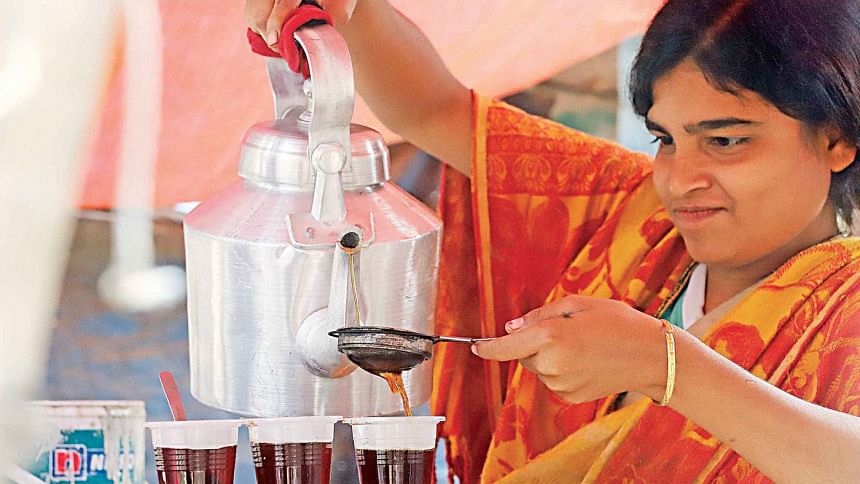Tea consumption crashes for first time since 2007

Drinking tea is increasingly becoming a part of family, social and professional life in Bangladesh as young, grownups and even kids alike like to take a sip at the world's most popular beverage.
Locals consumed more than 13 crore cups of tea daily before the pandemic hit the country in March last year as consumption has grown rapidly over the years driven by a combination of higher incomes, urbanisation, fast expanding middle-class and changing lifestyle.
Even people from the lower income groups have jumped on the bandwagon, evidenced from gatherings at tea stalls in the remotest part of the country, particularly in the evening.
Consumption, however, fell last year to its lowest level since 2007 due to the pandemic-induced lockdown.
Annual consumption reached 95.2 million kilograms in 2019, up from 36.95 million kgs in 2001, data from state-run Bangladesh Tea Board (BTB) showed.
This brought per capita tea consumption to more than 588 grams, or 294 cups a year. In total, people sip about 5,000 crore cups of tea, according to industry people.
The consumption, however, dropped to 84 million kgs last year due to the pandemic-induced lockdown, which forced hundreds of thousands of hotels, restaurants, tea stalls and offices across the country to shut operations from late March to early June last year.
The strict lockdown and the fear of catching the deadly virus from eating outside prompted consumers to turn to homemade tea, preventing the overall consumption from taking a sharp fall.
After the restrictions eased in June, consumption rebounded. Local sales of tea hover around Tk 3,500 crore a year, according to two people working in the industry.
Tea consumption has risen by two and a half times in the last two decades. Apart from 2020, consumption rose every year by 5.7 per cent in last nine years since 2011.
"Had there been no pandemic, the annual consumption could have crossed 100 million kgs last year," said Munir Ahmad, a deputy director of the BTB.
Availability of gas and electricity in the many rural areas has made tea a popular beverage as people stay up late and throng village centres, Ahmad said.
Prof Muhammad Sekandar Khan, vice-chancellor of East Delta University, said due to the rise in purchasing power, the consumption of less necessary items like tea is growing.
After meeting the expenses of daily necessities, people like to buy comforting items. "This can be seen as an indicator of a growing economy," said Khan, also a former professor of economics at the University of Chittagong.
Mohammad Sadek Hossain has been a popular tea stall owner at the busy Choumuhani area on the Sheikh Mujib Road in Chattogram city since 2000.
When he started his roadside stall, he managed to sell 60 to 70 cups of tea each day. Now, he sells 200 to 250 cups of tea every day.
"Once, people used to take a cup of tea every day. Now many people are seen taking more than one cup daily."
One of them is Khairul Bashar Arif. He lives abroad with his family. But he has been in his village home in Jamalpur for several months now.
He usually drinks six cups of tea between 5pm and 10pm every day, the time he usually spends with his friends.
"Sometimes, I drink more than that. I also drink tea at home with my family," said the 38-year-old.
Arif's parents have been drinking tea for the last four years and his 14-year-old sister Muntaha Mrittika also joined in.
Even, beggars used to beg tea in the past. Now, many of them are willing to pay for the beverage, Hossain said.
In the increasingly busy life, people do not have time to make a cup of tea, prompting companies to shift to tea-bag culture from selling loose tea.
Shah Moinuddin Hasan, chairman of the Tea Traders Association of Bangladesh, credited availability and reasonable price, among other factors, for the growing consumption.
Branded companies are ensuring the delivery of tea packs to tea stalls at the grassroot levels, said Hasan, also the general manager of MM Ispahani Ltd.
MM Ispahani Ltd has launched a campaign to develop the habit of making tea at home among the people in the rural areas, on the back of convenient packs at reasonable prices.
For Hasan Ali, a middle-aged villager in Hulain village in Patiya, going out during the afternoon for a cup of tea has become rare.
"Many villagers prefer drinking tea with other snacks along with family members as the price of branded tea packets is reasonable."
India and China dominate the global tea consumption market. But there are a few, small but dynamic newcomers, according to a report of the intern-governmental group on tea at the Food and Agricultural Organisation.
China, the largest consumer, reached an average growth rate for 10.1 per cent in the decade to 2016, followed by Israel (8.5 per cent), Kenya (7.1 per cent), Pakistan (6.1 per cent), Bangladesh (5.6 per cent), Libya (5.1 per cent), Malaysia (4.9 per cent), Germany (4.8 per cent), Turkey (3.9 per cent), Indonesia and Nepal (3.7 per cent), India and Brazil (3.5 per cent) and Saudi Arabia (3 per cent).
"A growing, increasingly urban, and young population segment entering the middle class is prepared to consume more and to pay for premium tea products. These changes have the potential to develop into a stronger and longer trend, which could characterise global tea consumption patterns for decades," the report said.
In Bangladesh, annual tea consumption may shoot to 130 million kgs by 2025.
"We are working to increase the domestic production keeping that in mind," Ahmad of the tea board said.
Some 86.39 million kilograms of tea were produced last year, down 10.01 per cent year-on-year, because of adverse weather, data from the BTB showed.



 For all latest news, follow The Daily Star's Google News channel.
For all latest news, follow The Daily Star's Google News channel. 




Comments